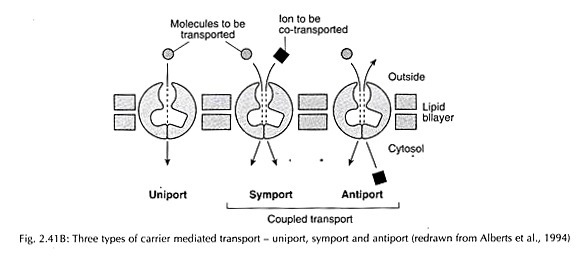Read this article to learn about the basic principles of sedimentation and also about sedimentation coefficient.
Basic Principles of Sedimentation:
The rate of sedimentation is dependent upon the applied centrifugal field (G) being directed readily outwards; this is determined by the square of the angular velocity of the rotor (ω in radians s-1) and the radians (r, in centimeters) of the particle from the axis of the rotation, according to the equation
G = ω2r.
Since one revolution of the rotor is equal to 2 radians, its angular velocity, in radians s-1, can be readily expressed in terms of revolutions per minute (rev min-1), the common way of expressing rotor speed being
ω = 2πrev min-1/60
The centrifugal field (G) in terms of rev min-1 is then
G = 4π2 (rev min-1)2r/3600
and is generally expressed as a multiple of the earth’s gravitational field (g = 981 cm s-1), i.e., the ratio of the weight of the particle in the centrifugal field to the weight of the same particle when acted on by gravity alone, and is then referred to as the relative centrifugal field (RCF) or more commonly as the ‘number times g’.
Hence:
RCF = 4π2 (rev min-1)2 r/3600 × 981,
which may be shortened to give
RCF = (1.118 × 10-5) (rev min-1)2 r.
Because rotors are different from various manufactures, we use RCF to represent the centrifugation force.
When conditions for the centrifugal separation of particles are reported, therefore, rotor speed, radial dimensions and time of operation of the rotor must all be quoted. Since biochemical experiments are usually conducted with particles dissolved or suspended in solution, the rate of sedimentation of a particle is dependent not only upon the applied centrifugal field but also upon the mass of the particle, which may be expressed as the product of its volume and density, the density and viscosity of the medium in which it is sedimenting and the extent to which its shape deviates from spherical.
When particle sediments it must displace some of the solution in which it is suspended, resulting in an apparent up-thrust on the particle equal to the weight of the liquid displaced. If a particle is assumed to be spherical and of known volume and density, the latter being corrected for the buoyancy due to the density of the medium, then the net outward force (F) it experiences when centrifuged at an angular velocity of ω radians s-1 is given by
F = 4/3πr3p (ρp – ρm)ω2r,
where 4/3πr3p is the volume of a sphere of radius rp, pp is the density of the particle, pm is the density of the suspending medium, and r is the distance of the particle from the centre of rotation. Particles, however, generate friction as they migrate through the solution. If a particle is rigid and spherical and moving at a known velocity, then the frictional force (F0) opposing motion is given by
F0 = vf,
where v is the velocity or sedimentation rate of the particle, and f is the frictional coefficient of the particle in the solvent. The frictional coefficient of a particle is the function of its size, shape and hydration, and of the viscosity of the medium, and according to the Stokes equation, for an un-hydrated spherical particle, is given by
F = 6πηrp,
where η is the viscosity coefficient of the medium.
For asymmetric and/or hydrated particles, the actual radius of the particle in is replaced by the effective of Stokes radius, reff. An un-hydrated, spherical particle of known volume and density, and present in a medium of constant density, therefore accelerates in a centrifugal field, its velocity increasing until the net force of sedimentation equals the frictional force resisting its motion through the medium, i.e.,
F = F0 or 4/3πr3p (ρp – Pm)ω2r = 6πηrpv.
In practice, the balancing of these forces occurs quickly and the particle reaches a constant velocity because the frictional resistance increases with the velocity of the particle. Under these conditions, the net force acting on the particle is zero. Hence, the particle no longer accelerates but achieves a maximum velocity, with the result that it now sediments at a constant rate. Its rate of sedimentation (v) is then given by
v = dr/dt = 2r2p (ρp -pm)ω2r = 9η.
It is evident from this equation that the sedimentation rate of a given particle is proportional to its size, to the difference in density between the particle and the medium and to the applied centrifugal field. It is zero when the densities of the particle and medium are equal; it decreases when the viscosity of the medium increases, and increases as the force field increases. However, since the equation involves the square of the particle radius, it is apparent that the size of the particle has the greatest influence upon its sedimentation rate.
Sedimentation Coefficient (S):
where S = terminal velocity / unit acceleration
Sedimentation coefficients have units of sec. 10-13 sec is called 1 Svedberg (or 1 S).
m = particle mass
f = frictional coefficient of the particle in the solvent
p = density of solution
v = particle velocity.
Characters of Sediment Coefficient (S):
1. S is increased for particle of larger mass (because sedimenting force in α man (1 – vr)).
2. S is increased for particle of larger density (equal volume).
3. S is increased for more compact structures (shape) of equal particle mass (frictional coefficient is less).
4. S is increased with rotational speed.




